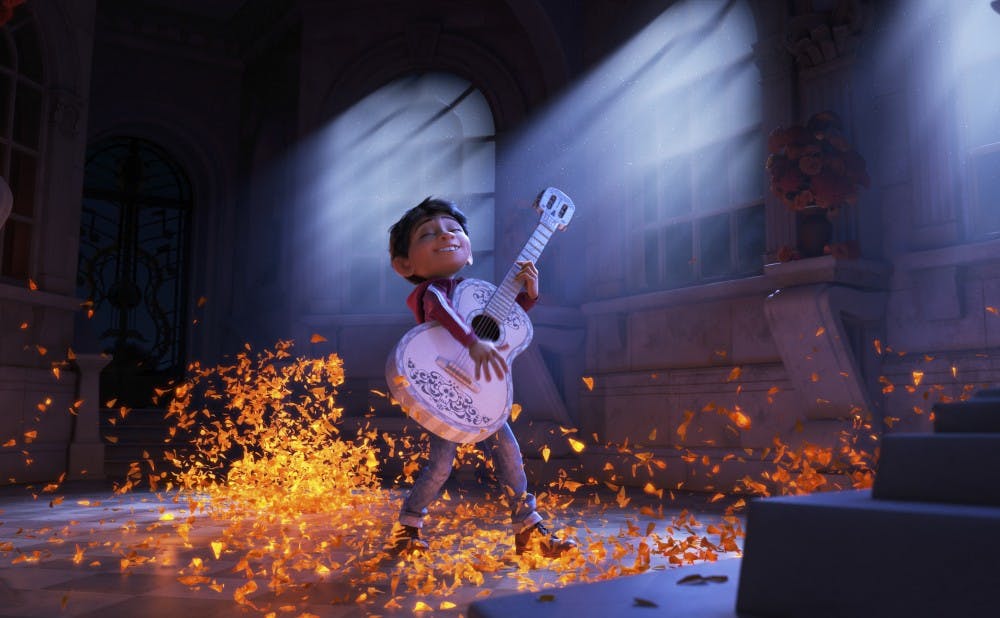Humanity is at the core of every Pixar film. Whether the company is encouraging audiences to sympathize with the monsters living under their beds or assigning rich inner lives to the contents of a child’s toy box, Pixar has a reputation for finding the humanity in the inhuman. Even the anthropomorphized emotions of “Inside Out” had feelings of their own.
But as the company has grown in size and notoriety, Pixar’s movies have started to smack of self-parody, simply taking a standard formula and squeezing life into its characters by brute force rather than meticulous artistry. Recent Pixar entries like “The Good Dinosaur” and “Cars 3” boast this glaring absence of humanity: both lacked the intelligence and heart of Pixar’s earlier films, appearing to favor marketability of characters over the tender moments and spirited storytelling that made films like “Toy Story,” “The Incredibles” and “Finding Nemo” the cultural touchstones they are today. When “Coco” was announced, audiences were justifiably wary not only of cultural appropriation — Día de los Muertos is frequently diminished, erased or portrayed as “Halloween south of the border” in the U.S. — but of yet another film desperate to cash in. Would the public be bombarded with sugar skulls and skeleton toys? Or had Pixar managed to find its humanity again, this time in the dead?
“Coco” opens with 12-year-old Miguel Rivera (Anthony Gonzalez) explaining his shoemaking family’s troubled relationship with music, spurred by his great-great-grandmother who was unceremoniously abandoned by her musician husband and channeled her grief into the shoemaking empire that her family still runs today. Miguel’s abuelita has completely banned music from the Rivera household, having seen the effect her father’s abandonment had on her mother Coco.
However, Miguel has secretly been teaching himself to play the guitar, inspired by renowned late musician Ernesto de la Cruz (Benjamin Bratt), whom he believes is his despised great-great-grandfather after finding a picture of his family with de la Cruz’s famous guitar in the corner. After his secret is found out, Miguel runs off on Día de los Muertos, tries to steal de la Cruz’s guitar from its shrine and finds himself trapped between the worlds of the living and the dead. His deceased relatives escort him back to the Land of the Dead, where his great-great-grandmother tries to send him back under the condition that he never play music again. Outraged, Miguel runs off in search of de la Cruz, knowing that his great-great-grandfather will send him back and enlists con artist Héctor (Gael García Bernal) to get him to de la Cruz and get him back to the world of the living before he becomes trapped in the Land of the Dead for eternity.
For all of its talk of the dead, “Coco” is absolutely bursting with life. From the labyrinthine cemeteries of Mexico to the breathtakingly beautiful streets of the Land of the Dead, every scene pulsates with light and sound and energy. Pixar’s remarkable world-building skills are at their sharpest here, transforming the already visually rich renderings of the fabled Land of the Dead into an off-kilter, luminescent wonderland, complete with resplendent towers and rickety slums. Co-director and writer Adrian Molina does an admirable job weaving Mexican culture into the story and manages to illuminate some of the more confusing concepts of Día de los Muertos without too much clunky exposition. Even if “Coco” had been just as emotionally hollow as Pixar’s past few efforts, it still would have been worth admission price just to see the glorious landscapes unfold on the big screen.
“Coco,” however, is the furthest thing from hollow. It is one of Pixar’s most emotional features to date, jerking viciously at the heartstrings and plucking guitar strings with similar ease. The theme of family, particularly in the context of remembering one’s family and making sure one’s loved ones endure even after they leave this world, is expressed beautifully and explored in full beyond the basic notions of appreciating elders. Miguel must learn to respect his ancestors, but his ancestors must also learn to respect him and accept his love for music as an essential part of his identity. It is a terrific lesson that hopefully will leave an impression on audiences.
While far from perfect — the movie borrows heavily from previous Pixar films when it comes to its themes of hero worship, making its twist incredibly predictable — “Coco” is a refreshingly polished, poignant entry into the Pixar canon. The company has come a long way since requesting to actually trademark the term Día de los Muertos: there is nothing but admiration for the Mexican culture and people. Leave it to Pixar to not only find the humanity and soul in the dead but to bring its suffering reputation back to life.
Get The Chronicle straight to your inbox
Signup for our weekly newsletter. Cancel at any time.

